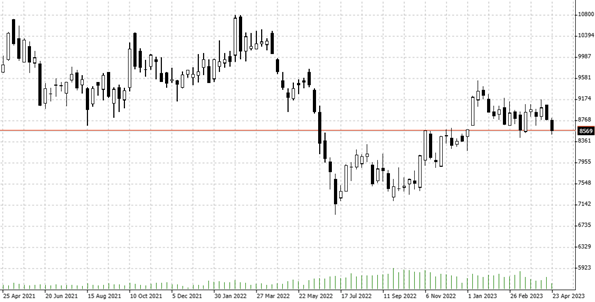

26.04.2023 – The red metal is the clinical thermometer of the global economy. That’s because copper is used in cables of all kinds in electronics. That’s why it’s particularly important in the Western world’s green transformation plan: more electric cars and solar panels are supporting demand. However, there are definitely factors for a bear market: for example, a sluggish global economy or higher interest rates. It is not yet clear where the journey is heading.
A clear trend can hardly be discerned in the weekly chart at the moment. If you are looking for bullish or bearish facts, you currently have a rich choice on every page – please help yourself.

Source: Bernstein Bank GmbH
The website “Tradingeconomics.com” recently judged that concerns about weaker offtake are overriding fears of falling supply. Thus, investors are far from impressed with Chinese demand after the reopening of the economy post Corona.
Pros and cons
Meanwhile, the apparent return of stability at U.S. banks provided a template for the Federal Reserve to raise interest rates further, “Tradingeconomics.com” further explained. However, the market is receiving support from London Metal Exchange inventories – at 56,000 tons, they are as low as they were last in 2005. Chile’s state-owned mining group Codelco has also announced that production in 2023 will fall by around 7 percent year-on-year. Whereas there had already been a decline of around 11 percent in 2022. We add: A special factor is the unstable situation in Peru, which provides about 10 percent of global supply.
Wave of mergers due to looming shortage
Some industry representatives, meanwhile, are warning of a looming severe shortage of the metal, as industry service Fastmarkets reported from the annual Cesco Week in Chile (Centro de Estudios des Cobre y la Mineria). In any case, the website referred to the boom in company acquisitions, with which large corporations tried to compensate for the presumably declining supply. As an example, “Fastmarkets” cited the purchase of Oz Minerals by BHP and the acquisition of Copper Mountain by Hudbay Mineral. In addition, Glencore is currently bidding for Canada’s Teck Resources.
The motivation behind this: Few mining groups are prepared to invest billions in the development of new mines and wait around a decade for the first output – buying up competitors is easier. However, according to Fastmarkets, this does not address the real problem, which is the shortage of metal. Ragnar Udd, president of BHP Minerals Americas, also warned that the world needs nine or ten giant mines on the scale of Escondida to manage the energy transition in a decade. Escondida is Chile’s largest copper mine, with output of about one million tons per year.
Energy turnaround versus a sluggish economy
Roland Harings, CEO of Aurubis, painted a more differentiated picture. In an interview with “Fastmarkets”, he said that the copper market was currently well supplied from the perspective of a European smelter, and that there was a large supply of concentrates and recycling products. In fact, he said, demand is high, which is also due to the energy transition. In any case, the move away from fossil fuels outweighs the effect from a somewhat weaker global economy. However, global inflation is causing wages to pick up, he added. We add: Which should ultimately be added to prices.
Our conclusion from all this is that there is no clear trend for copper at present. We will continue to keep an eye on the situation for you – and wish you good luck with your trades and investments!
_________________________________________________________________________________________________________
The content of this publication is for general information purposes only. In this context, it is neither an individual investment recommendation or advice nor an offer to purchase or sell securities or other financial products. The content in question and all the information contained therein do not in any way replace individual investor- or investment-oriented advice. No reliable forecast or indication for the future is possible with respect to any presentation or information on the present or past performance of the relevant underlying assets. All information and data presented in this publication are based on reliable sources. However, Bernstein Bank does not guarantee that the information and data contained in this publication is up-to-date, correct and complete. Securities traded on the financial markets are subject to price fluctuations. A contract for difference (CFD) is also a financial instrument with leverage effect. Against this backdrop, CFD trading involves a high risk up to the point of total loss and may not be suitable for all investors. Therefore, make sure that you have fully understood all the correlating risks. If necessary, ask for independent advice. CFDs are complex instruments and are associated with the high risk of losing money quickly because of the leverage effect. 68% of retail investor accounts lose money trading CFD with this provider. You should consider whether you understand how CFD work and whether you can afford to take the high risk of losing your money.7
